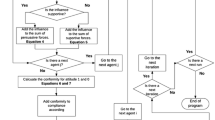Abstract
Building on the growing literature that views organizations as complex adaptive systems, this paper proposes a general model to analyze the relationship between organizational context and attitudes. In particular, we focus on how the system of formal and informal communication channels that characterize an organization and the timing of information flows affect the dynamic process of attitude change. We also use a stylized version of the model to illustrate how the general framework is able to generate insights that are relevant to particular situations.
Similar content being viewed by others
References
Ajzen, I. (1987), “Attitudes, Traits and Actions: Dispositional Prediction of Behavior in Personality and Social Psychology,” Advances in Experimental Social Psychology, 20, 1–63.
Ajzen, I. (1988), Attitudes, Personality and Behavior. Open University Press.
Ajzen, I. and M. Fishbein (1977), “Attitude-Behavior Relations: A Theoretical Analysis and Review of Empirical Research,” Psychological Bulletin, 84, 888–918.
Anderson, P. (1999), “Complexity Theory and Organization Science,” Organization Science, 10, 216–232.
Bueno de Mesquita, B. and F.N. Stokman (Eds.) (1994), European Community Decision Making: Models Applications and Comparisons. Yale University Press, New Haven.
Burkhart, R. (1996), “The SWARN Simulator: Applications in Science and Business,” Embracing Complexity: Exploring the application of Complex Adaptive Systems to Business, Ernst & Young Center for Business Innovation, Cambridge, MA.
Brief, A.P. (1998), Attitudes in and Around Organizations. Sage.
Carley, K. and Z. Lin (1997), “A Theoretical Study of Organizational Performance Under Information Distortion,” Management Science, 43(7), 976–997.
Coleman, J.S. (1972), “Systems of Social Exchange,” Journal of Mathematical Sociology, 2, 145–163.
Coleman, J.S. (1973), “Loss of Power,” American Sociological Review, 38, 1–17.
DeGroot, M. (1974), “Reaching a Consensus,” Journal of the American Statistical Association, 69, 118–121.
Fishbein, M. and I. Ajzen (1974), “Attitudes Towards Objects as Predictors of Single and Multiple Behavioral Criteria,” Psychological Review, 81, 59–74.
French, J. Jr. (1956), “A Formal Theory of Social Power,” The Psychological Review, 63, 181–194.
Friedkin, N. (1986), “A Formal Theory of Social Power,” Journal of Mathematical Sociology, 12, 103–126.
Friedkin, N. (1990), “Social Networks in Structural Equations Models,” Social Psychology Quarterly, 53, 316–328.
Friedkin, N. (1991), “Theoretical Foundations for Centrality Measures,” American Journal of Sociology, 96, 1478–1504.
Friedkin, N. (1993), “Structural Bases of Interpersonal Influence in Groups:ALongitudinal Case Study,” American Sociological Review, 58, 861–872.
Friedkin, N. and K. Cook (1990), “Peer Group Influence,” Sociological Methods and Research, 19, 122–143.
Friedkin, N. and E. Johnsen (1990), “Social Influence and Opinions,” Journal of Mathematical Sociology, 15, 193–205.
Friedkin, N. and E. Johnsen (1997), “Social Positions in Influent Networks,” Social Networks, 19, 209–222.
Griffin, R.W. (1983), “Objective and Social Sources of Information in Task Redesign: A Field Experiment,” Administrative Science Quarterly, 28, 184–200.
Heider, F. (1958), The Psychology of Interpersonal Relations. John Wiley and Sons.
Heydebrand, W. (1989), “New Organizational Forms,” Work and Occupations, 16, 323–357.
Hubbell, C. (1965), “An Input-Output Approach to Clique Identification,” Sociometry, 28, 377–399.
Hummon, N.P. and T.J. Fararo (1995), “Actors and Networks as Objects,” Social Networks, 17, 1–26.
Jick, T.D. (1993), Managing Change. Irwin.
Kanter, R.M., B.A. Stein and T.D. Jick (1992), The Challenge of Organizational Change. Free Press, New York.
Katz, L. (1953), “A New Status Index Derived from Sociometric Analysis,” Psychometrika, 18, 39–43.
Kotter, J.P. and J.L. Heskett (1992), Corporate Culture and Performance. Free Press, New York.
Krackhardt, D. and J.R. Hanson (1993), “Informal Networks: The Company Behind the Chart,” Harvard Business Review, 71, 104–111.
Krackhardt, D. and R.N. Stern (1988), “Informal Networks and Organizational Crisis: An Experimental Simulation,” Social Psychology Quarterly, 51, 123–140.
Lawrence, P.R. and J.W. Lorsch (1967), Organization and Environment: Managing Differentiation and Integration. Harvard University Press, Boston, MA.
Marsden, P. (1981), “Introducing Influence Processes into a System of Collective Decisions,” American Journal of Sociology, 86, 1203–1235.
Mintzberg, H. (1983), Structures in Five: Designing Effective Organizations. Prentice Hall, Inc., Englewood Cliffs, NJ.
Pratkanis, A. and M. Turner (1994), “Of What Value is a Job Attitude? A Socio-Cognitive Analysis,” Human Relations, 47, 1545.
Salancik, G.R. and J. Pfeffer (1978), “A Social Information Processing Approach to Job Attitudes and Task Design,” Administrative Science Quarterly, 23, 224–253.
Sanders, K., T. Snijders and F.N. Stokman (1998), “Editorial: Effects and Outcomes of Informal RelationsWithin Organizations,” Computational and Mathematical Organization Theory, 4, 103–108.
Schein, E.H. (1985), Organizational Culture and Leadership. Jossey-Bass, Sab Francisco, CA.
Stokman, F.N. (2001), Social Networks. International Encycolpedia of the Social & Behavioral Sciences, pp. 1–12.
Stokman, F.N. and R. Van Oosten (1994), “The Exchange of Voting Positions: An Object-Oriented Model of Policy Networks,” in B. Bueno de Mesquita and F.N. Stokman (Eds.) European Community Decision Making: Models Applications and Comparisons, Yale University Press, New Haven, pp. 105–127.
Simon, H.A. (1996), The Sciences of the Artificial. 3rd ed. MIT Press, Cambridge, MA.
Weiss, H.M. and C.E. Nowicki (1981), “Social Influence on Task Satisfaction: Model Competence and Observer Field Dependence,” Organizational Behavior and Human Performance, 27, 345–366.
Author information
Authors and Affiliations
Rights and permissions
About this article
Cite this article
Costa, L.A., de Matos, J.A. Towards an Organizational Model of Attitude Change. Computational & Mathematical Organization Theory 8, 315–335 (2002). https://doi.org/10.1023/A:1025468602019
Issue Date:
DOI: https://doi.org/10.1023/A:1025468602019




